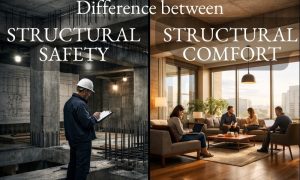🕑 Reading time: 1 minute
Pre-Engineered buildings are being preferred over conventional buildings for industrial construction due to its fast construction. Following is the comparison between Pre-Engineered building and Conventional Buildings for steel structures, which shows advantages of pre-engineered buildings over conventional buildings.What are Pre-engineered Steel Buildings?
Pre-engineered steel buildings are constructed using steel built up sections which are designed and fabricated in the factory and assembled at the site of construction using bolted connections.
Fig 1: Pre-engineered Steel building
What are Conventional Steel Buildings?
Conventional steel buildings are traditional metal structures constructed by rolled steel sections which are designed individually and fabricated at site using welding and cutting.
Fig 2: Conventional Steel Building
Comparison of Pre-engineered with Conventional Steel Buildings
Comparison of Pre-engineered steel buildings with conventional steel buildings with respect to several properties like design, structural weight, performance, cost, responsibility etc. are tabulated below.| S.No | Property | Pre-Engineered Steel building (PEB) | Conventional Steel Buildings |
| 1 | Design | Design of Pre-engineered buildings is efficient due to its integral framing system. | Design of conventional buildings takes more time and it offer fewer precision design aids. |
| 2 | Codes used for Design | International design codes such as AISC, AISI, MBMA and AWS are used all over the world. | Codes are not updated and traditional codes given by IS are used. |
| 3 | Computer Software | Computer programs are available for the design of Pre-engineered buildings. Design, estimation, detailing, drawings etc. can be generated within no time using this software. | No such development is available in case of conventional buildings. |
| 4 | Structure Weight | Structural Members used are tapered built up sections and are 10 to 20% lighter than conventional buildings. | Structural Members used are Hot rolled T-sections which are of heavy weight. |
| 5 | Foundations | Since the structural weight is low, Lightweight foundation with simple design is enough. | Heavy structural weight makes it difficult to design the foundation. Foundation must be very heavy enough to bear the loads. |
| 6 | Delivery Speed | Faster delivery. It takes 6 to 8 weeks to construct 500 MT pre-engineered building after finalization of design. | Very slow delivery. It takes 20 to 26 weeks to construct 500 MT conventional building after finalization of design |
| 6 | Cost of Construction | Price per square meter is 30% less than the cost of conventional building. | Price per square meter is very much higher. |
| 7 | Seismic Resistance | These buildings offers good resistance against seismic actions since it is made of Lightweight flexible members. | These cannot withstand against seismic forces because of their rigid heavy frames. |
| 8 | Architecture | Impressive architectural options are available at low costs. | More research and time is needed. Cost also will increase. |
| 9 | Future Expansion of Building | It is easy to expand the pre-engineered building because of its simple connection design. | It requires heavy budget and also difficult to expand the building. |
| 10 | Performance | Maximum efficiency can be achieved since all the components are designed specially to act together as a system. | Components are designed individually and hence there is no guarantee about the performance of structure. |
| 11 | Responsibility | Only one supplier took the responsibility of whole project which is good for minimizing construction risks. | Multiple suppliers took the responsibilities and issues like insufficient materials, different quality components etc. may arise. |
| 12 | Clear Span | Members of pre-engineered buildings can offer large clear span up to 100 to 120 m without any intermediate supports. | Maximum clear span offered by the conventional building members is 40 m only. |
| 13 | Erection Simplicity | Erection of PEB members is so simple and faster. Light equipment is enough. | Erection in this case is slower and demands more labor. Heavy equipment is necessary. |
| 14 | Building accessories | All components of pre-engineered buildings are interchangeable at reasonable cost. | Use of specially designed accessories makes it difficult to find its replacements and increases the cost complexity of project. |


